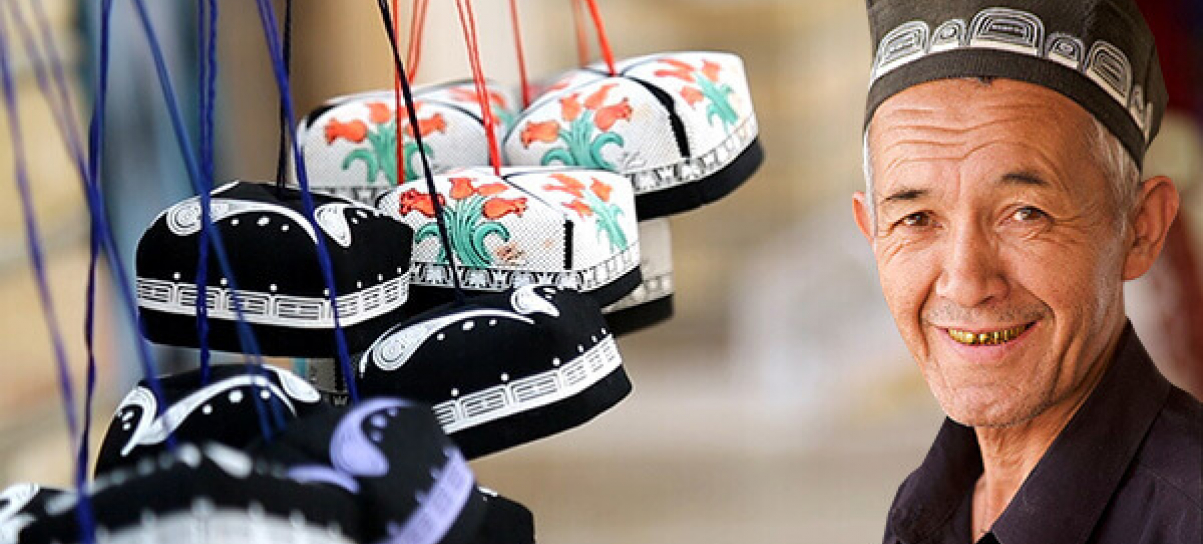National Headdress of Uzbekistan
"White and black. Two poles - two beginnings. The black square - cosmos and darkness. Four white segments - rotation and solar symbol. The look is frozen, vanishing in the whirl. In a moment, you will disappear in the vortex - calmness" - wrote Sergey Alibekov about Uzbek tyubeteika.
According to ancient beliefs, the four flowers on the top protect the health of a wearer and sixteen flowers (sixteen children) along the edge guarantee a large and harmonious family. Another version interprets the flowers, embroidered with white silk on a white background, as a symbol of the pure soul and heart.
The laconic pattern is a distinctive feature of the male cap. Female and children's tyubeteikas are richer. The ornament is closely connected with the spiritual life, customs and poetic mind of the people.

Uzbek Tyubeteyka (uzbek scullcap)
The experts can not agree on origin of the word "tyubeteika". By the way, in Samarkand, it is called "kalpok", while in the other regions - "doppi". Anvar Ahmedov, the expert in national traditions, thinks that Turkic "doppi" was transformed into "tyubeteika" through Tatar "tubaetei" ("tubae" -top). "Doppi" and "Tubae" have the common radix, and both languages belong to the Turkic group.
As an integral part of Uzbek national costume, the tyubeteika has become a subject of national sayings, proverbs, riddles and humor. If the Uzbek wants to emphasize, that some matter will be immediately done, he says "Doppingni bir ailantirguncha" ("While you are turning your tyubeteika around your head").
One day, a bald man dropped his tyubeteika .into the stream. Despairing, he was rushing about the bank, trying to take it from water. Nevertheless, the tyubeteika, alas, was floating away further and further. Understanding that "all his efforts are in vain, he said: "Well, let it float. In fact, it was too small for me".
Uzbek riddles give fancy descriptions of tyubeteika, first of all, its decoration: "On the head - the rim, in the rim - the moth"; "She is single, but has four faces and sixteen kiddies"...
This headdress often plays a role of a close friend and adviser. When one should concentrate and consider a situation, the people say: "Put your tyubeteika on the ground and consult with it instead of a friend".
Tyubeteikas are made from two or several layers of a fabric, which are fixed with silk or cotton threads. Stitches go from edges to the center as radiuses, and as cross parallel lines - on vertical band. More often, tyubeteikas are made of velvet, sateen and baize. Male tyubeteikas are often sewn from black sateen and velvet. Female ones - from polychromic silk, velvet and brocade. The experts define six types of tyubeteikas: Tashkent, Fergana, Samarqand, Bukhara, Kashkadarya-Surkhandarya and Khorezm-Karakalpak.
The State Museum of History of Uzbekistan has the richest collection of these original headdresses. There are more than 300 unique samples, having been collected for over 120 years.
We can get a view of various tyubeteikas not only in museum halls, but also on postage stamps. "Uzbekistan markasi" issued a special set representing the best samples of national art. The set consists of seven stamps exposing tyubeteikas of the 19th - 20th centuries.
Unfortunately, we can often see, how ancient ornamental styles, having been formed for centuries, are falling into stagnation. However this is not the case with the tyubeteika, which remains stable.
We recommend to see more:
Follow us on
Sign up for our newsletters
Find our latest discounted tours, updated itineraries and latest news about the region



